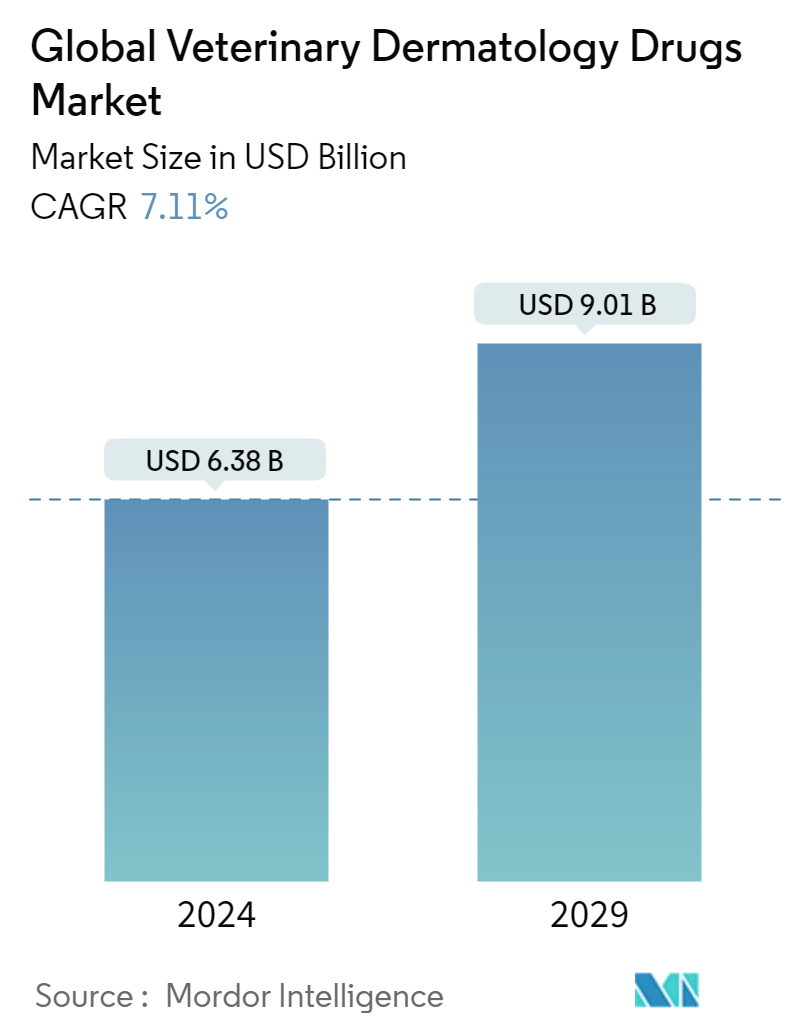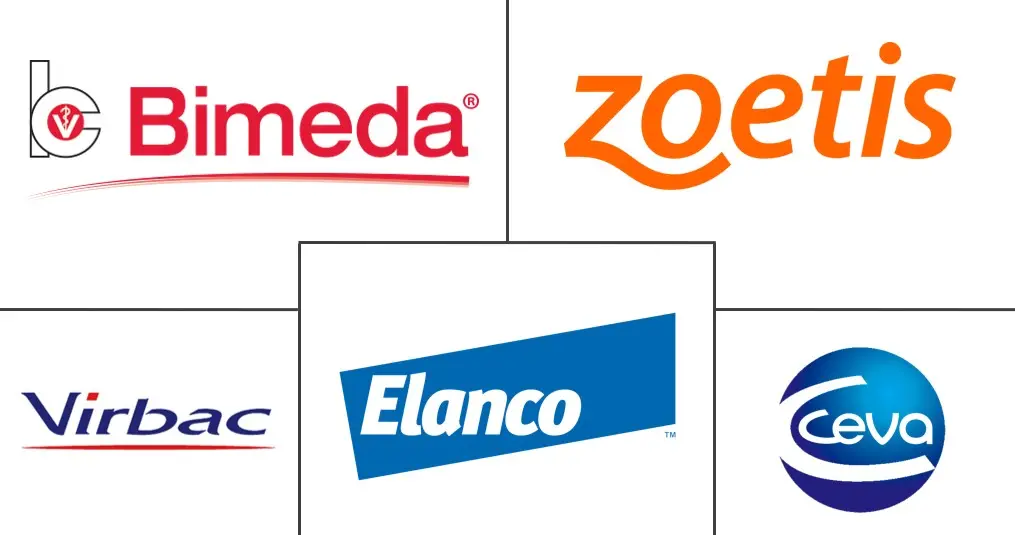Market Size of Global Veterinary Dermatology Drugs Industry

| Study Period | 2019 - 2029 |
| Market Size (2024) | USD 6.38 Billion |
| Market Size (2029) | USD 9.01 Billion |
| CAGR (2024 - 2029) | 7.11 % |
| Fastest Growing Market | Asia-Pacific |
| Largest Market | North America |
| Market Concentration | High |
Major Players
*Disclaimer: Major Players sorted in no particular order |
Veterinary Dermatology Drugs Market Analysis
The Global Veterinary Dermatology Drugs Market size is estimated at USD 6.38 billion in 2024, and is expected to reach USD 9.01 billion by 2029, at a CAGR of 7.11% during the forecast period (2024-2029).
Factors such as an increasing burden of dermatological diseases in pet animals and increasing pet adoption and animal care are expected to garner the demand for the availability of dermatology drugs available for veterinary use. They are anticipated to drive the overall market growth during the forecast period.
Most animals globally are affected by major skin diseases like parasitic skin diseases, alopecia, dander-related skin disorders, intrinsic skin infections, mild to harmful skin cancer, autoimmune skin diseases, and other internal skin abnormalities. For instance, according to a study published in the Veterinary Sciences Journal in July 2022, atopic dermatitis (AD) is one of the most common pet allergies. In dogs, the prevalence has become increasingly common due to rising exposure to indoor environments and processed foods for pets. Hence, the burden of AD among canines is rising and is creating demand for the availability of dermatology drugs. This is anticipated to fuel the growth of the market in the country.
Moreover, increasing pet adoption is expected to contribute to the growth of the market over the forecast period. For instance, According to the 2023-2024 American Pet Product Association (APPA) National Pet Owners Survey, about 66% of households in the United States owned a pet, which translates to about 86.9 million homes. Cats and dogs were the major pets, with a total population of 45.3 million and 69 million, respectively.
Furthermore, the growing availability of research sources and company research and development activities to innovate new products are the factors fueling competitiveness in the market. For instance, in September 2022, Boehringer Ingelheim announced today the U.S. Food and Drug Administration has approved SPEVIGO, the first approved treatment option for generalized pustular psoriasis (GPP) flares in adults. SPEVIGO is a novel, selective antibody that blocks the activation of the interleukin-36 receptor (IL-36R), a key part of a signaling pathway within the immune system shown to be involved in the cause of GPP. As better dermatological health is crucial for pets, pet owners, and livestock animals, the increasing number of products is expected to contribute to the growth of the veterinary dermatology drugs market.
However, the low availability and lack of awareness of the drugs might restrain the market growth over the analysis period.
Veterinary Dermatology Drugs Industry Segmentation
As per the scope of this report, veterinary dermatology is also known as veterinary skin care. Skin disorders are the most common medical conditions that are seen in animals due to licking, biting, repeatedly shaking their heads, and excessive scratching of their fur and skin. Veterinary dermatology drugs are used to treat skin infections or skin diseases in animals, mostly companion animals and livestock animals. The veterinary dermatology drugs market is segmented by animal, route of administration, distribution channel, and geography. By animal, the market is segmented as companion animal, livestock animal. By route of administration, the market is segmented as topical, injectable, and oral. By indication, the market is segmented as parasitic infections, allergic infections, and other indications. By distribution channel, the market is segmented as retail, hospital pharmacies, and e-commerce). By geography, the market is segmented as North America, Europe, Asia-Pacific, Middle East and Africa, and South America. The market report also covers the estimated market sizes and trends for 17 countries across major regions globally. The report offers the value (in USD) for the above segments.
| By Animal | |
| Companion Animal | |
| Livestock Animal |
| By Route Of Administration | |
| Topical | |
| Injectable | |
| Oral |
| By Indication | |
| Parasitic Infections | |
| Allergic Infections | |
| Other Indications |
| By Distribution Channel | |
| Retail | |
| Hospital Pharmacies | |
| E-commerce |
| Geography | ||||||||
| ||||||||
| ||||||||
| ||||||||
| ||||||||
|
Global Veterinary Dermatology Drugs Market Size Summary
The veterinary dermatology drugs market is poised for significant growth, driven by the increasing prevalence of skin diseases in pets and the rising adoption of companion animals. The demand for dermatological treatments is fueled by the growing awareness of pet health and the need for effective solutions to common skin conditions such as atopic dermatitis, allergies, and infections. The market is characterized by a competitive landscape with key players actively engaging in research and development to introduce innovative products. The availability of new treatments and the expansion of product portfolios by companies like Boehringer Ingelheim and Pet King Brands are expected to enhance market dynamics and cater to the evolving needs of pet owners.
North America is anticipated to lead the market growth, supported by high pet ownership rates and increased spending on animal healthcare. The region's developed economies, particularly the United States and Canada, are witnessing a surge in demand for veterinary dermatology drugs due to the high prevalence of skin conditions in pets. The market's expansion is further bolstered by strategic initiatives such as mergers, acquisitions, and new product launches by major players like Zoetis and Elanco. Despite challenges like limited drug availability and awareness, the market is set to grow steadily, with North America maintaining a prominent position due to its robust animal health infrastructure and consumer awareness.
Global Veterinary Dermatology Drugs Market Size - Table of Contents
-
1. MARKET DYNAMICS
-
1.1 Market Overview
-
1.2 Market Drivers
-
1.2.1 Increasing Burden of Dermatological Diseases in Pets
-
1.2.2 Increasing Pet adoption and Animal Care
-
-
1.3 Market Restraints
-
1.3.1 Low availability and Lack of awareness of the drugs
-
-
1.4 Porter's Five Forces Analysis
-
1.4.1 Threat of New Entrants
-
1.4.2 Bargaining Power of Buyers/Consumers
-
1.4.3 Bargaining Power of Suppliers
-
1.4.4 Threat of Substitute Products
-
1.4.5 Intensity of Competitive Rivalry
-
-
-
2. MARKET SEGMENTATION (Market Size by Value - USD)
-
2.1 By Animal
-
2.1.1 Companion Animal
-
2.1.2 Livestock Animal
-
-
2.2 By Route Of Administration
-
2.2.1 Topical
-
2.2.2 Injectable
-
2.2.3 Oral
-
-
2.3 By Indication
-
2.3.1 Parasitic Infections
-
2.3.2 Allergic Infections
-
2.3.3 Other Indications
-
-
2.4 By Distribution Channel
-
2.4.1 Retail
-
2.4.2 Hospital Pharmacies
-
2.4.3 E-commerce
-
-
2.5 Geography
-
2.5.1 North America
-
2.5.1.1 United States
-
2.5.1.2 Canada
-
2.5.1.3 Mexico
-
-
2.5.2 Europe
-
2.5.2.1 United Kingdom
-
2.5.2.2 France
-
2.5.2.3 Germany
-
2.5.2.4 Italy
-
2.5.2.5 Spain
-
2.5.2.6 Rest of Europe
-
-
2.5.3 Asia-Pacific
-
2.5.3.1 India
-
2.5.3.2 China
-
2.5.3.3 Japan
-
2.5.3.4 Australia
-
2.5.3.5 South Korea
-
2.5.3.6 Rest of Asia-Pacific
-
-
2.5.4 Middle East and Africa
-
2.5.4.1 GCC
-
2.5.4.2 South Africa
-
2.5.4.3 Rest of Middle East and Africa
-
-
2.5.5 South America
-
2.5.5.1 Brazil
-
2.5.5.2 Argentina
-
2.5.5.3 Rest of South America
-
-
-
Global Veterinary Dermatology Drugs Market Size FAQs
How big is the Global Veterinary Dermatology Drugs Market?
The Global Veterinary Dermatology Drugs Market size is expected to reach USD 6.38 billion in 2024 and grow at a CAGR of 7.11% to reach USD 9.01 billion by 2029.
What is the current Global Veterinary Dermatology Drugs Market size?
In 2024, the Global Veterinary Dermatology Drugs Market size is expected to reach USD 6.38 billion.

